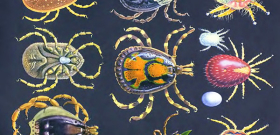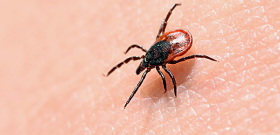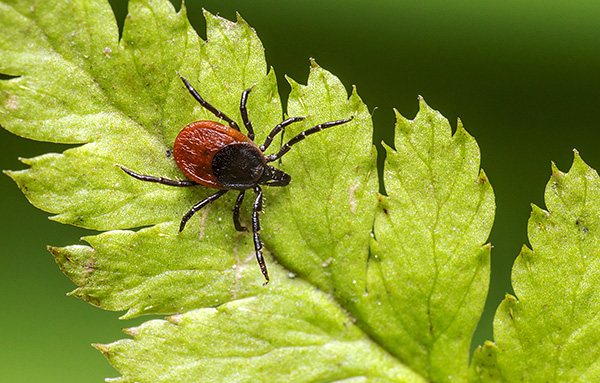
The dog tick, whose Latin name is Ixodes ricinus (Linnaeus, 1758), is the most widespread and widespread representative of the Ticks (Acari) subclass of the Arachnida class. In the Russian-language literature, the name of the species has several synonyms, the most frequently used of which is the term "European forest tick".
Like other ixodid ticks, the dog tick is a temporary obligate exoparasite of humans and domestic animals. To survive and reproduce, it needs to feed on the blood of several hosts, the change of which occurs many times during the life of the parasite.
The photo below shows a female dog tick fed on blood:

The dog tick lives almost everywhere, its range covers all continents except Antarctica. Such a wide distribution allowed the species to firmly gain a foothold in a wide variety of ecosystems and adapt to feeding on various animals, the number of species of which exceeds several dozen.
In addition, Ixodes ricinus is a carrier of pathogens of a number of dangerous natural focal diseases that infect humans and animals by bloodsucking, thus contributing to the spread of infections. The most dangerous for people are various forms of encephalitis, hemorrhagic fever, tick-borne typhus and some other infections, the carrier and reservoir of which is the dog tick.
On the features of the biology of the parasite and its danger to humans, we will discuss in more detail later ...
Where does the dog tick live?
The European forest tick (also known as a dog tick) is common in North Africa (the territory of Tunisia and Algeria), Europe and Asia. In the Neoarctic, its localization is represented by rare populations of North America. The dog tick is also often found in the Baltics - Lithuania, Estonia and Latvia. The species is widespread in almost all countries of the former USSR.

The northern border of the distribution of the species in Russia passes through Karelia, the Leningrad and Nizhny Novgorod regions, passing to the left bank of the Volga in the Samara region. Further, the boundaries of the range follow south along the floodplain of the indicated river.
The northern border in Ciscaucasia lies along the lower reaches of the Don and the north of the Krasnodar Territory, reaching here the Terek valley. Then the border follows east, up to the Chechen Republic, and goes around the greater Caucasus, leaving for Azerbaijan.
The dog tick prefers deciduous, coniferous-deciduous forests and open spaces with shrub vegetation as habitats.
On a note
In the north, in a cold climate, the tick chooses dry, well-heated areas, that is, it is a xerophile. In the south, it prefers damp shaded habitats. This phenomenon is well known to entomologists and acarologists and is called the law of zonal change of stations. Therefore, when determining the possible places of mass concentrations of the parasite, you should take into account the characteristics of the natural zone in which you are located. If in the south of Russia the dog tick is a typically forest species, then in the north it can mainly move to open arid spaces with a clear predominance of herbaceous vegetation.
Another important point worth paying attention to is that mass outbreaks of the parasite occur more often in the north than in the south. This is due to the conditions that arise in rough terrain after deforestation, where pasturelands are subsequently formed. A large number of animals accumulate on these lands, which are the hosts of adult ticks and their larvae.
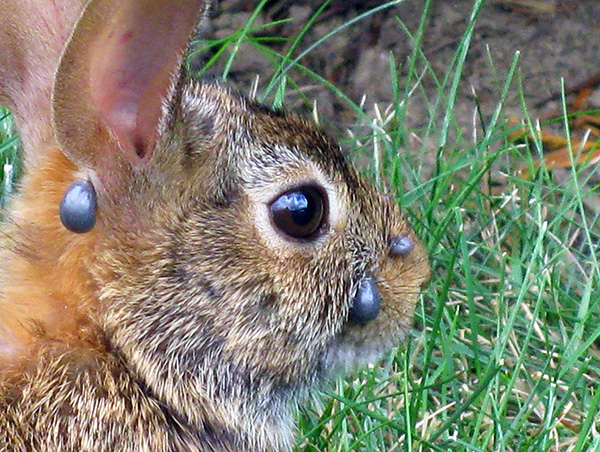
The abundance of food and favorable microclimatic indicators give impetus to a sharp increase in the number of hemoparasites. It is in such areas that it is easiest and most likely to pick up a dog tick.
The structure of the parasite
The body of an adult tick looks bag-like, consists of elastic elastic tissues that can significantly change size, depending on the degree of saturation. The body color of the dog tick is usually brown, but can vary from light gray to dark brown.
In the photo below, the brown color of Ixodes ricinus is clearly visible:
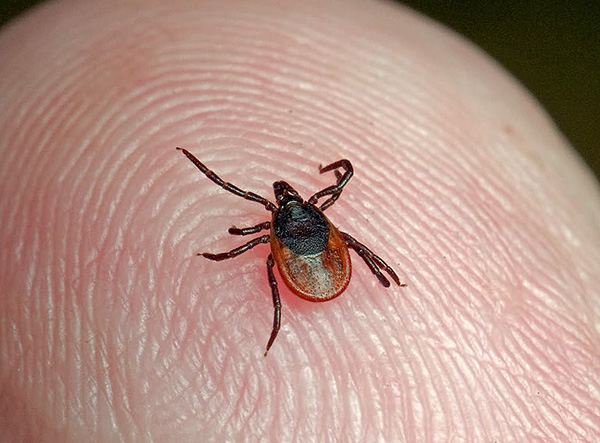
Attached to the front of the body is a complex of oral appendages called the gnathosoma. This is the head section of the parasite, it has a complex structure.
Feelers are attached near the mouthparts, which perform a sensitive function. At the base of the head section there is a pair of chelicerae that look like sharp knives bent towards the top. With them, the tick cuts the skin of the victim when feeding.
If you look at the oral appendages under a microscope, then below (between the chelicerae) you can see a cone-shaped outgrowth studded with sharp hooks - this is the hypostome (the so-called proboscis). It is he who is introduced into the wound of the victim and through it the blood is absorbed. The injection action is carried out due to powerful contractile movements of the esophagus.
The photo below clearly shows what a dog tick hypostome looks like under a microscope:
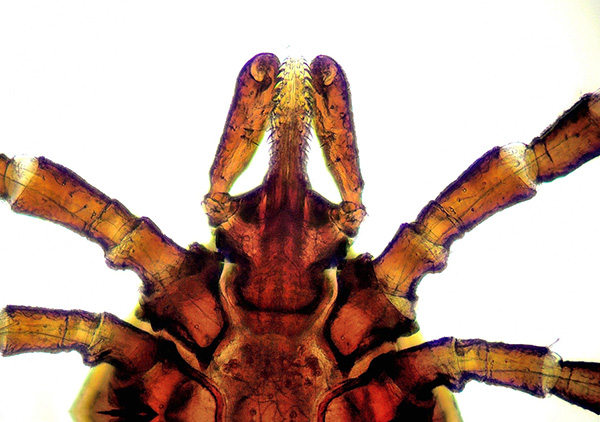
It is interesting
Hooks on the hypostome can be arranged in several rows in the form of a corolla. Their number and location is of taxonomic significance, that is, by the nature of the placement and morphology of the hooks, one can determine the type of tick and give its description.
The hooks are oriented in such a way that they do not interfere with the introduction of the proboscis into the tissue, but after that they are securely held in the skin. That is why the tick should never be pulled out by force after it has stuck. This is fraught with separation of the abdomen from the head - as a result, the head with the proboscis will remain in the wound, causing suppuration.

Behind the complex of oral appendages, one can see a constriction that separates the head section from the body (idiosomes). The idiosoma has completely lost its segmentation and looks like a convex sac from above.
The body is covered from above with chitinous shields, which are not connected to each other. When the ticks are hungry, lighter furrows of elastic tissues are visible between these shields. It is they who create a kind of pattern.
In the anterior part there is a dark burgundy, rarely red, shining dorsal shield, covered with sparse setae. It is by its size that one can unmistakably distinguish a male from a female: in a female, this shield covers 1/3 of the back, and in a male, completely the entire back. This is primarily due to the characteristics of the vital activity of the sexes: females feed more often and in large volumes, which is due to the need for reproduction and oviposition.
The body ends with anal and genital openings, which are slightly shifted to the ventral side.
The photo shows a female and male dog tick:
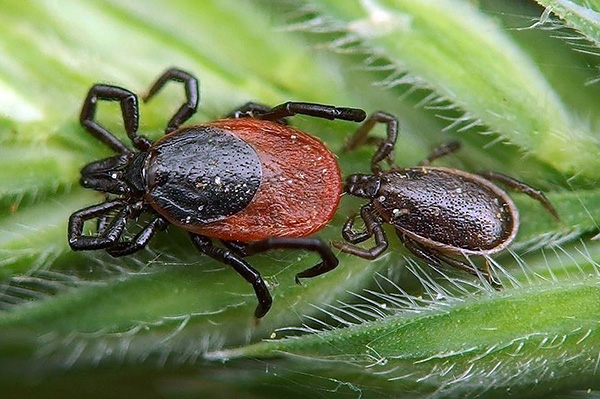
All ticks have 4 pairs of walking legs, while all insects are six-legged.
On a note
People often consider ticks to be insects, which is wrong. These parasites, like spiders, are not insects.
The limbs have a jointed structure and end with claws that perform a trailing function when the ticks sit on their prey. The front pair of legs bears organs of chemical sense, with the help of which the parasites unmistakably find their future host.
Larvae differ from adults in the number of legs - there are six of them. Nymphs already have 8 limbs, but they have not yet developed a genital opening.
It is worth saying that all types of ixodid ticks are very similar to each other, and differ only in a number of signs that are not so easy for an ordinary person to notice. For example, only a specialist can distinguish a dog tick from a taiga one, especially in those habitats where their ranges intersect. The appearance of these parasites is very similar, and the differences in morphology are the presence of spines and membranous appendages on the inner edge of one of the walking leg segments. The parasites are also similar in the nature of trophic relationships (in both cases, a wide range of hosts).
Accordingly, only a specialist can accurately determine which particular tick stuck to a person or animal.
Life cycle of Ixodes ricinus
The life cycle of all ixodid ticks consists of 4 stages of ontogenesis:
- eggs;
- larvae;
- nymphs;
- imago (adult).
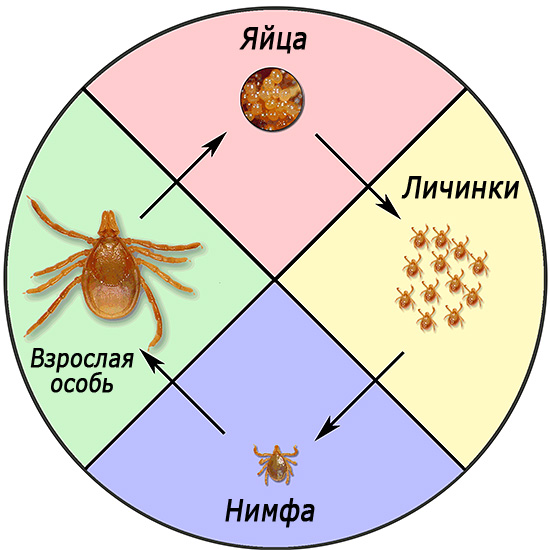
The development of the dog tick takes place according to the three-host type. This means that in the process of growth and development, one individual feeds on 3 different hosts, passing through one of the active stages of ontogeny. Development can last from 1.5 to 3 years, depending on climatic conditions and food supply.
The activity of Ixodes ricinus begins after the snow melts and ends with the onset of the first frost. Thus, these arachnids are active during most of the year. But activity during this period is different, its peak falls on the spring and autumn seasons, when the weather conditions are characterized by a fairly high temperature and the degree of humidity of both air and soil.
On a note
The high number in the spring-autumn period is due not only to weather conditions. Mass character is created by individuals of two generations: adult ticks that overwintered in leaf litter, and young individuals that recently molted from nymphs - the generation of the current year.
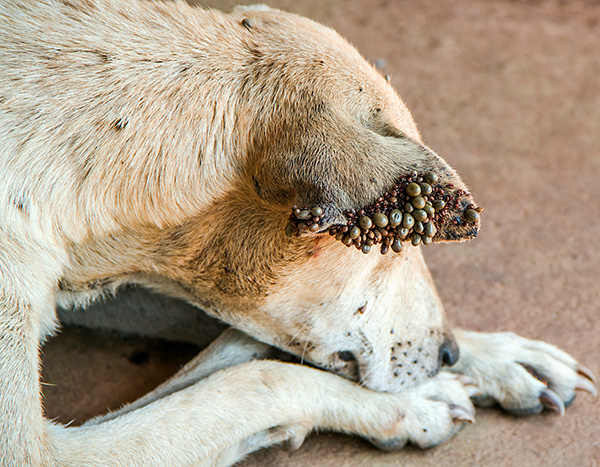
In summer, compared with spring and autumn, the number of active individuals of the dog tick becomes minimal. For example, in the floodplain and ravine forests of the steppe zone, adults of ticks do not occur at all during the summer period, since they often fall into thermal suspended animation.
Larvae of Ixodes ricinus are found already in April, but their maximum activity is observed in June and July. Nymphs appear in late April - early May and are recorded until early November. At the same time, two peaks of activity are recorded in the summer: the third decade of May and the beginning of June, as well as July - the beginning of August.
The meeting of the sexes occurs both in the natural environment and on the host, on which the male and female feed simultaneously.
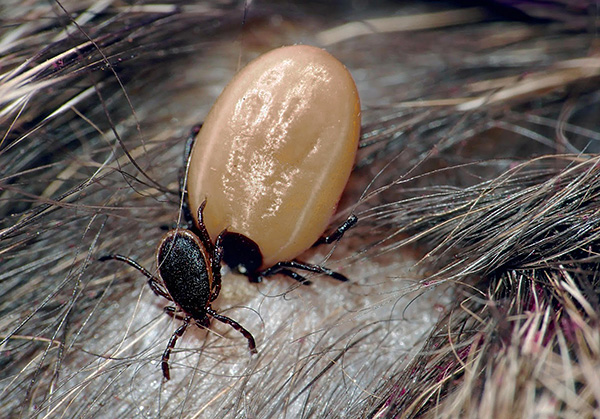
After fertilization, the female feeds on the same host for some time, or actively seeks out a host. This is very important, since for the timely and complete maturation of eggs, nutrition with a large amount of blood is necessary. In science, this dependence is called gonotrophic harmony.For the same reason, females are more bloodthirsty - they drink more blood and suck it longer than males.
The laying of eggs by females of the dog tick is carried out in the natural environment, and the egg productivity of the parasite is colossal, and amounts to thousands of eggs laid by one individual. This compensates for the high mortality of young animals.
The photo shows the laying of eggs by a female dog tick in the forest floor:
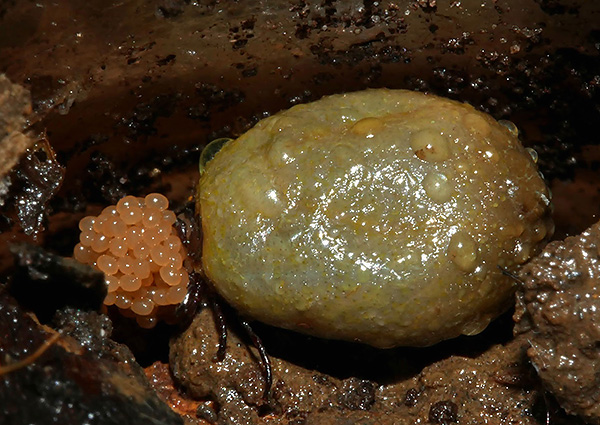
The development of eggs lasts up to 20 days, the hatched larvae develop for a month. During this period, they need to find a host and feed themselves in order to gain strength for the upcoming molt.
Nymphs take 30 to 40 days to develop, during which time nutrition is also vital.
In hot and dry weather, the timing of development can be shifted by a week or more. Many experts are of the opinion that with a further increase in the intensity of global warming, the dog tick will become increasingly active in early spring and in the autumn-winter period, which may increase the incidence of diseases carried by ticks.
Seasonal peaks in the number of dog ticks are determined by their density in nature and the level of activity, which depend both on the state of the populations of the parasite and its possible hosts, and (to a large extent) on the weather. Daily activity depends on the temperature factor.
Adult individuals overwinter in the same habitats where they are active: in leaf litter, in cracks in tree bark, under stones and in dead wood. With the onset of positive temperatures, these parasites go hunting.
Meals and change of owners
Ticks react to the appearance of a person or animal already from a distance of about 10 meters. Basically, the parasite navigates with the help of chemical sense organs located on the front pair of legs.
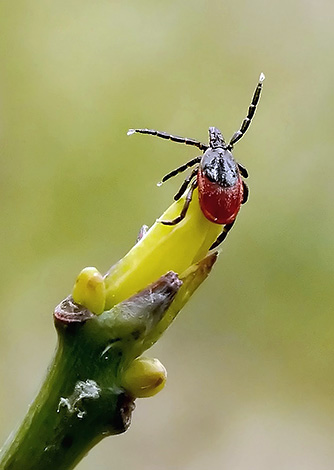
On a note
It is precisely because ticks are able to detect the approach of a possible host that they often concentrate in places of mass visitation by animals and people: along forest paths, in pastures, along the banks of reservoirs, in parks and squares. It is in such places that it is most likely to pick up a parasite.
Dog ticks form clusters on vegetation in places favorable for hunting and freeze in a waiting position. At the very top of the grass, the tick lingers on six hind legs, stretching the front pair. Thus, the parasite "monitors" the chemical composition of the surrounding air.

On the other hand, such an expectant posture allows you to instantly attach to the wool or clothing of a potential owner. As soon as the tick catches the irritant, it turns the body in the direction of its action and waits for the host to approach it. If this does not happen, then the tick descends to the substrate and begins to crawl towards the victim, as if pursuing it.
But dog ticks cannot actively attack large vertebrates, primarily due to their small size and insufficiently fast movement. In addition, with increased activity, the arthropod quickly loses moisture and is forced to restore the water balance in wet habitats, interrupting the pursuit.
The dog tick is polyphagous, that is, it is characterized by a wide range of animals on which it is able to feed. Imago often sit on cattle, deer, dogs, cats, foxes, raccoon dogs, hares.Small mammals are avoided as the blood supply to their skin may not be sufficient for full satiation.
It is well known that hedgehogs and squirrels are distinguished among the main hosts of nymphs. Less commonly, nymphs are found on deer, hares, dormouse, mice, voles, moles, shrews, and cattle.
Birds are of great importance as the dominant hosts of the immature phases of Ixodes ricinus. Feeding often occurs on birds that nest on the ground or often lead a terrestrial lifestyle: nightingales, tits, sparrows, skates, thrushes, buntings, warblers, etc.
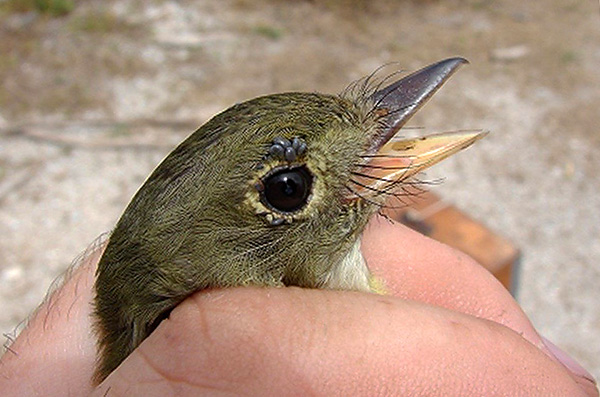
It is interesting
Birds are natural carriers of ticks, helping them migrate over considerable distances. The phenomenon of the transfer of invertebrates by large animals is well known in nature and is called "phoresis".
Sedentary birds are a powerful factor in maintaining the size of the tick population.
The hosts of the larvae are mainly small rodents: dormouse, mice, shrews, voles, squirrels. Sometimes food is carried out on moles, mole rats, hares, hedgehogs. Among birds, the larvae of dog ticks most often attach themselves to the forest pipit, hazel grouse, robin, chaffinch and crested tit.
Thus, the dog tick is characterized by a wide range of hosts. They can feed on all of these animals, however, these arachnids at each stage of ontogeny have preferential trophic links. It follows from this that the name of the species (Dog tick) does not reflect its food preferences in any way. In addition to dogs, Ixodes ricinus feeds on more than 100 animal species, including humans.
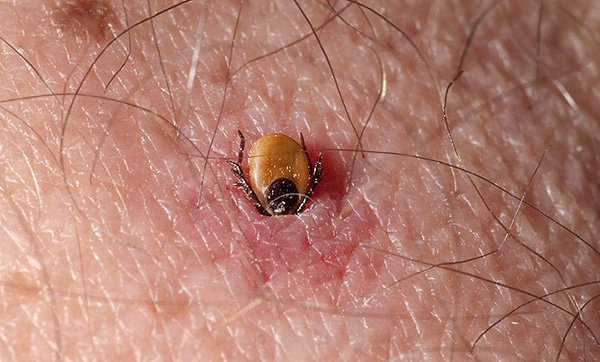
There is an opinion among the inhabitants that a cat tick is found on cats, similar to a dog tick in dogs. However, this is fundamentally not true.In general, there is no such species as a cat tick (like a human one). Often, the same species sticks to both dogs and cats if the animal has entered the zone of mass reproduction of the parasite.
Accordingly, ticks do not have such a pronounced selectivity for food contacts. It is this circumstance that carries the danger of the dog tick as the main carrier of pathogens of serious diseases from wild animals to humans.
medical significance
The medical significance of the dog tick is determined primarily by the fact that this parasite is a carrier and reservoir of pathogens of dangerous infections: choriomeningitis, Scottish encephalitis, eastern encephalomyelitis, St. Louis encephalitis, tick-borne viral encephalitis, viruses - Langat, Kemerovo, Kumlinge, West Nile, Crimean hemorrhagic fever.
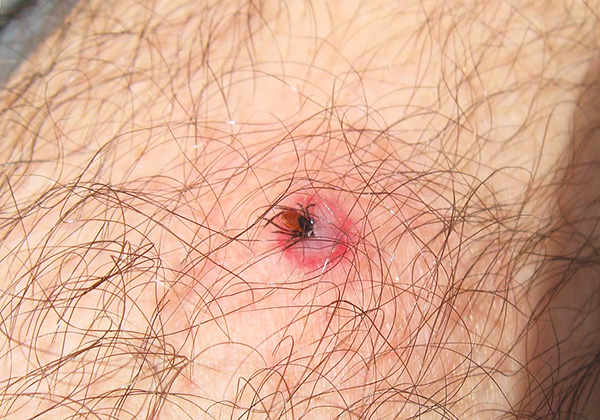
It has also been established that the dog tick is a carrier of pathogens of bacterial infections: tularemia, listeriosis, erysipeloid and rickettsiosis: Q fever, Rocky Mountain spotted fever, paroxysmal rickettsiosis, tick-borne typhus of Central Asia. It is for this reason that specialists have repeatedly attempted to fight the populations of this blood-sucking parasite.
The most common and frequently found in humans and domestic animals are:
- tick-borne spring-summer encephalitis;
- Scottish encephalitis;
- Q fever;
- tick-borne borreliosis (Lyme disease).
Tick-borne spring-summer encephalitis
Tick-borne spring-summer encephalitis is an acute viral disease that is characterized by a sudden and rapid onset of the disease, fever and severe damage to the central nervous system.The disease is natural-focal, and is common in the north of Russia, the Far East and in the Central European part. Natural reservoirs are wild animals (often rodents), and vectors are ticks of the genus Ixodes. In particular, the dog tick is the main carrier of the pathogen from wild animals to humans.
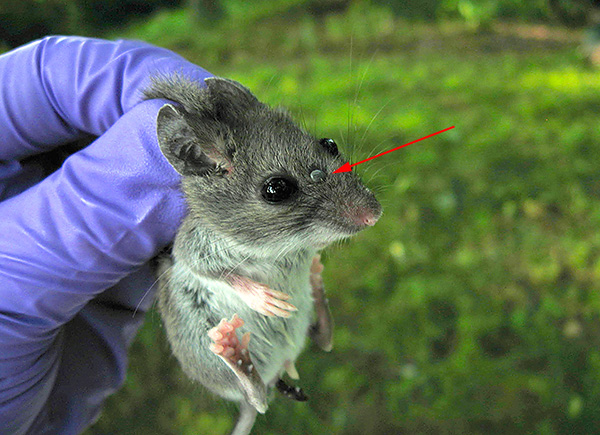
As a rule, even at the stage of the larva or nymph, the arachnid becomes infected with a virus during bloodsucking. The tick transmits the causative agent of tick-borne encephalitis to all subsequent hosts, and the longer the dog tick feeds, the higher the likelihood of infection with the subsequent development of the disease.
On a note
Tick-borne encephalitis is also transmitted by the taiga tick (Ixodes persulcatus). However, its habitat is shifted to the north, so the northern and Far Eastern regions suffer from it. Many scientists believe that this encephalitis has a different form, which is more pathogenic than that carried in the central part of the country by Ixodes ricinus.
Scottish encephalitis
Scottish encephalitis is an infectious disease that affects mainly sheep, less often horses and pigs. Occasionally transmitted to humans - mainly if he visits agricultural pastures and there he is attacked by infected parasites.

Symptoms of the disease are typical for encephalitis: muscle weakness, drowsiness, headaches, fever. The disease passes in two phases with an exposure of about a week. However, unlike the usual spring-summer encephalitis, the treatment of Scottish encephalitis in most cases ends with a complete recovery of the person.
Q fever
Q fever is an acute natural focal disease caused by Burnet's rickettsiae.The disease is characterized by an acute chronic course and primary severe damage to the respiratory tract, causing first bronchitis, and then pneumonia.
The photo below shows the bacteria Coxiella burnetii at high magnification:
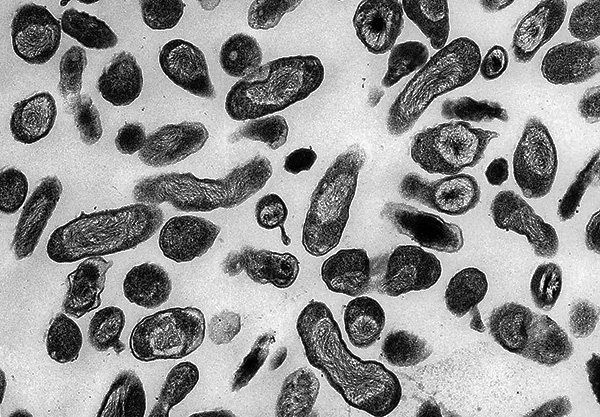
The foci of the disease exist both in the wild (wild artiodactyls, rodents) and can be anthropourgical (the source is farm animals: cattle, sheep, pigs, horses, poultry).
Carriers are ixodid ticks, in particular the dog tick. An infected parasite, feeding on a new host, defecates to free the intestines for new portions of blood. Together with excrement, rickettsia also come out. Through a wound in the skin, pathogens enter the human or animal body - this is how infection occurs.
Tick-borne borreliosis
Tick-borne borreliosis (Lyme disease) is an acute bacterial disease that affects the central nervous system, cardiovascular system, muscle tissue, and organs of the gastrointestinal tract.
Natural reservoirs of pathogens are wild animals: deer and rodents, as well as domestic dogs, sheep and cattle can be reservoirs of infection. The dog tick carries pathogens from animals to humans.
In Russia, this disease is very common and almost everywhere, although for the first time in our country it was noted only in 1985.
It is possible to determine that it was a tick infected with Borrelia that has bitten as follows: after a few hours, annular inflammation (annular erythema) occurs at the site of the bite, and the borders of redness can migrate after some time. If you notice this symptom, you should immediately consult a doctor.
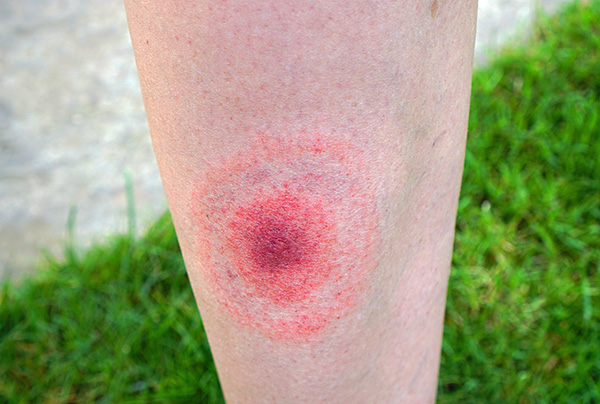
What to do with a tick bite
The main defense against dog tick-borne diseases is the prevention of parasite bites. In the spring-autumn period, when the activity of ticks is maximum, it is worth avoiding places of their mass accumulation. Do not go out into nature without closed clothing that would prevent the tick from getting on the body.
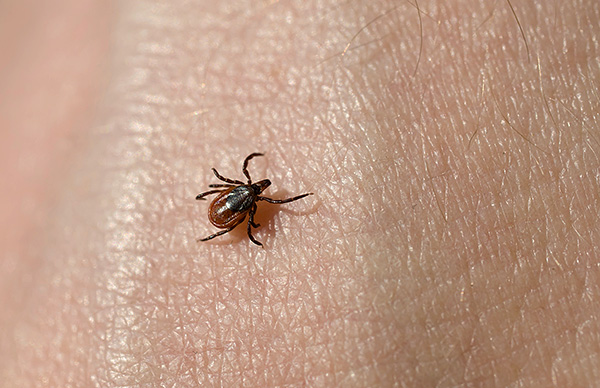
You should inspect pets after walks, as they can bring parasites into the house on their hair.
If the tick is still stuck, then:
- There is no need to panic - sucking on a parasite is only dangerous if it is infected. According to statistics, only a small percentage of ticks are carriers of pathogens of dangerous diseases. Moreover, even if the bitten parasite turns out to be infected, the probability of developing the disease is approximately 2 to 6% (for tick-borne encephalitis);
- It is necessary to carefully remove the parasite from the skin, and as quickly as possible. In no case should it be pulled out by force or, moreover, crushed. If you are not sure that you can do the necessary manipulations on your own, then consult a doctor;
- After removing the tick, wash your hands thoroughly with soap and water;
- The parasite must be placed in a vial and delivered to a virological laboratory for analysis.
The dog tick is looking for a comfortable place to suck


